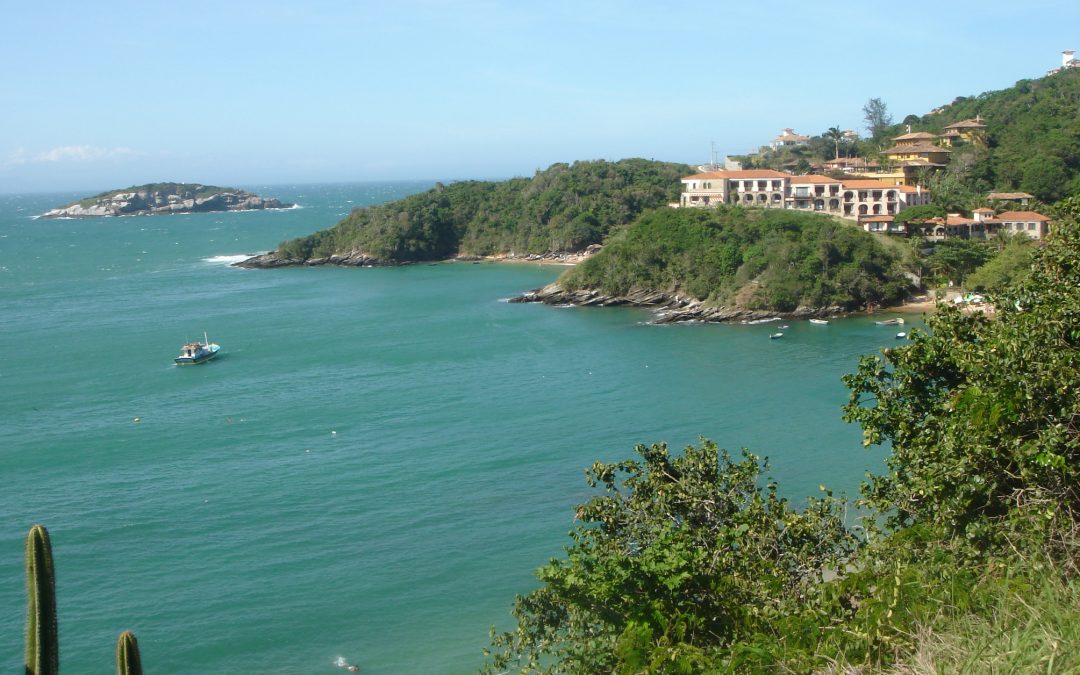TRAVEL BLOG 3
March 4 – 8
Armaçao dos Búzios & Salvador da Bahia
Armaçao dos Búzios
At 7:00 a.m., the ship sailed into Búzios, a vacation destination nestled into the hills of a peninsula just northeast of Rio de Janeiro. From our ship, it resembled an upscale resort town in Italy or France. But when we came ashore and viewed its many beaches in an open-air streetcar, the look and feel was much more Caribbean – with vibrant colors, loud street music and busy harbors lined with rustic fishing boats.


We learned that in the early 1900s, Búzios was popular with the high society, who wanted to escape the chaotic city life of Rio de Janeiro and enjoy relaxing on the more than 23 beaches that the peninsula offers. But really, it wasn’t until 1964, with the fame of Brigitte Bardot coming to Búzios to try to escape the paparazzi, that it grew to be a popular tourist destination. During its high season, the town grows from 25,000 to around 200,000 inhabitants.
One of the things we found fascinating about this area is that the vegetation consists of an unusual mix of desert cacti and tropical rainforest flora, side by side. Lush rubber trees with bright purple orchids hugging their branches stood beside – literally touching – saguaro cacti like the ones we have in Arizona. When we asked about it, the response had to do with the simultaneous existence of unusually high humidity and a very arid climate (less than 60 days with any rain each year). In fact, the humidity today felt like constant hot misting on our skin!


Day at Sea
We thought we might try to describe some of our 424 fellow travelers. Given the number of excursions in kayaks and zodiacs, especially once we sail into the wilds of the Amazon, we expected a somewhat younger set here than on most cruises. Although the cruise did attract a few younger folks, many of the guests are aged (like us) and frequently not aged particularly well. Overweight – and the abundance of excellent food onboard does much to expand this. Crippled. Bad knees. Bad backs. Last night, I overheard a lengthy conversation at the table next to us comparing the effects of various dosages of Lisinopril.
But we’ve met some remarkable exceptions. Daniel (originally from Argentina) and his wife Goldie (originally from Mexico) live in Connecticut. He’s a neurosurgeon who trained at Baylor, worked at Mayo among other institutions, and is currently on the faculty at Yale. Daniel met Evita Perón in Argentina shortly before her death in 1952, when he was just a young boy. He and a team of other neuroscientists conducted years of research and published a book and numerous articles on the mysterious and controversial politics and ethics surrounding the supposed frontal lobotomy of Eva Perón. His theory (and he provided considerable evidence for his position during an onboard presentation) is that Juan Perón ordered the lobotomy to curtail his wife’s increasingly aggressive maneuvers against the Peronista party (in addition to easing the pain of her cancer).
Then there’s Brad, a graduate of the Wharton Business School—one of the top five in the world – who built and ran a successful brokerage business. He and Donna now live in Montana. Fishing is their passion. And there’s Randy, an oil (pronounced with one syllable, like “all”) man from Oklahoma and his vivacious and delightful wife Jaime. Truly a pleasure to be around! And there are Sir Jonathon Band, who used to be the head of the British Royal Navy, and his wife Lady Sarah Band. He’s on the board of Carnival, the parent company of our cruise line, so we all enjoyed exceptional service the night we dined with them at their table.
By contrast, we have noticed how bored and/or unhappy many of the cruise passengers appear to be. This prompted Ed and me to check in with each other about what we have found most interesting on this cruise. The answer was immediately clear to both of us: the hours of snuggling in the morning before getting up, playing tai chi together, and the writing we do each day – the same activities we also enjoy most when we’re at home. The new experiences this trip has added to our lives are also very satisfying, and it is certainly educational to travel to these diverse South American locations. But we were again reminded that we always take ourselves with us, no matter where we go. If we’re excited about our lives, we’re likely to be excited cruise travelers. If not, well…then probably not.
Today we were invited to join the captain and some of his officers on the bridge. Fantastic! The First Officer showed us the various instrument panels and knobs and explained their purposes. I remember very few of the details.
What I do remember is the vast expanse of water all around us as we stood staring at its immensity from the bridge. I glanced at Ed and knew we were thinking the same thing: We are such a tiny, insignificant speck in this universe.
A large white bird, flying in front of the bridge window, captured my attention.
“How does that bird survive out here above the ocean with no place to land?” I asked.
“That’s an albatross,” said the officer. “They eat fish. And they can fly up to a whole year without ever landing. Often, they fly alongside us without even flapping their wings, simply soaring along, lifted by the air currents produced by our ship.”
Salvador da Bahia
Salvador is the capital of Brazil’s northeastern state of Bahia. It is best known for its Portuguese colonial architecture, Afro-Brazilian culture and, of course, its tropical coastline.
A sharp escarpment divides the town’s lower and upper districts by 85 meters. The Elevador Lacerda, Brazil’s first elevator, has connected the two since 1873. The Pelourinho district of the upper town is the city’s historic heart, with cobblestone alleys opening onto large squares, colorful buildings and baroque churches. It is considered the birthplace of Brazilian culture.


Salvador was the first slave port in the Americas, and the African influence of the slaves’ descendants makes it a center of Afro-Brazilian way of life. They were brought in, initially from Angola, to work the vast sugar cane plantations. These early slaves brought two important things with them that still form a large part of Brazilian culture: the Capoeira dance (a martial art) and acarajé (a dish of peeled black-eyed peas formed into a ball and deep-fried in red palm oil).
The traditional Capoeira was an African ritual of slow and continuous movements, done illegally in secret during colonial times. By 1940, it was an almost completely forgotten art form. Someone referred to as Master Bimba is credited for having resurrected it as a uniquely Brazilian art form combining fight, dance and rhythm into captivating movement. The photo doesn’t do justice to this remarkable dance form, but our videos wouldn’t load onto this site.

In the early 1700, slaves started to build their own Catholic church, “Our Lady of the Rosary of the Black Man,” because they weren’t allowed to enter the other cathedrals in the city. They worked during the day for their masters, and built the church at night. It was completed about 100 years after its construction began. I found it particularly interesting that the statues in the church depicted Joseph and the Virgin Mary as black, but displayed Jesus as a white baby.

By contrast, nearby, stands the Cathedral of St. Francis, considered the richest church in Brazil (decorated in baroque style with a half ton of gold). It seemed to us like an odd juxtaposition, St. Francis and opulence.

Stay tuned … more in four days.


Dancing fighters, Catholic churches in close proximity that feel like they must be designed by people from different planets, people who look like they may be from the same species, but are taking very different intellectual and emotional trips through life, and a reported small spike in illness on the ship. In addition, Marlena and I practice our tai chi as the waves around the ship unpredictably move the deck under our footing to surprising locations.
So much stimulation in our environment sometimes leaves me feeling a bit overwhelmed. What a blessing to have the privilege of learning, growth and awaking for our elderly brains.
And what really makes it work is the joy of retreating together into our soothing world of quiet support as our stateroom door closes behind us.
Isn’t there a song about “behind closed doors”…????
You two are soaking it in with all your senses and sensibilities. Such richness of colors and cultures and history. Your vivid descriptions and photos really set the scene and teach us as well. I am enjoying South America, if vicariously.
Very insightful that we take ourselves with us, wherever we go. (Isn’t there some song like that?) And you take your exuberance with you.
Can’t wait to exhuberate with you and Carl very soon!
Thank you for another descriptive and educational entry. The personal insights and the people watching are my favorite! It’s great to be able to join you on this journey .
Thanks for that, Joelle. I was wondering if I meandered too much into personal musings…thank you for the feedback. I’m thinking the next blog will contain some thoughts about “entitlement,” which is a topic Ed and I have been discussing quite a lot during the past few days. One of the wonderful things about cruising, we’ve found, is that we spend hours talking to each other:-)
Hi Marlena und Edd, schoen von euch zu lesen sehr interesant wie ihr es erlebt, und es ist wie du schreibst wir nehmen uns mit und sind so wie wir uns gepraegt haben,wir haben viel Regen etwas zu viel auf einigen Stellen, aber uns gehts gut love you both John und Susi
Najo, im Chaco gibt es immer zu viel oder zu wenig Regen, neh???